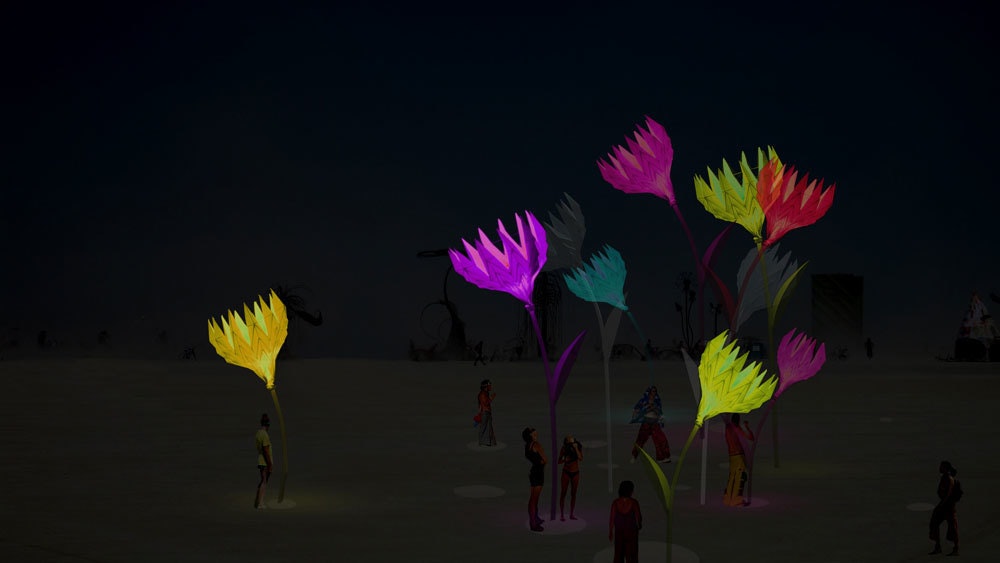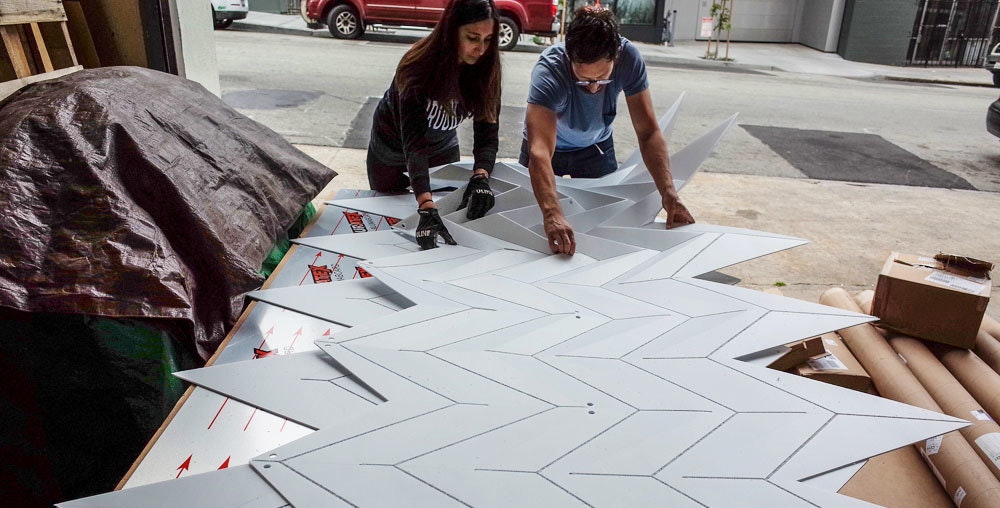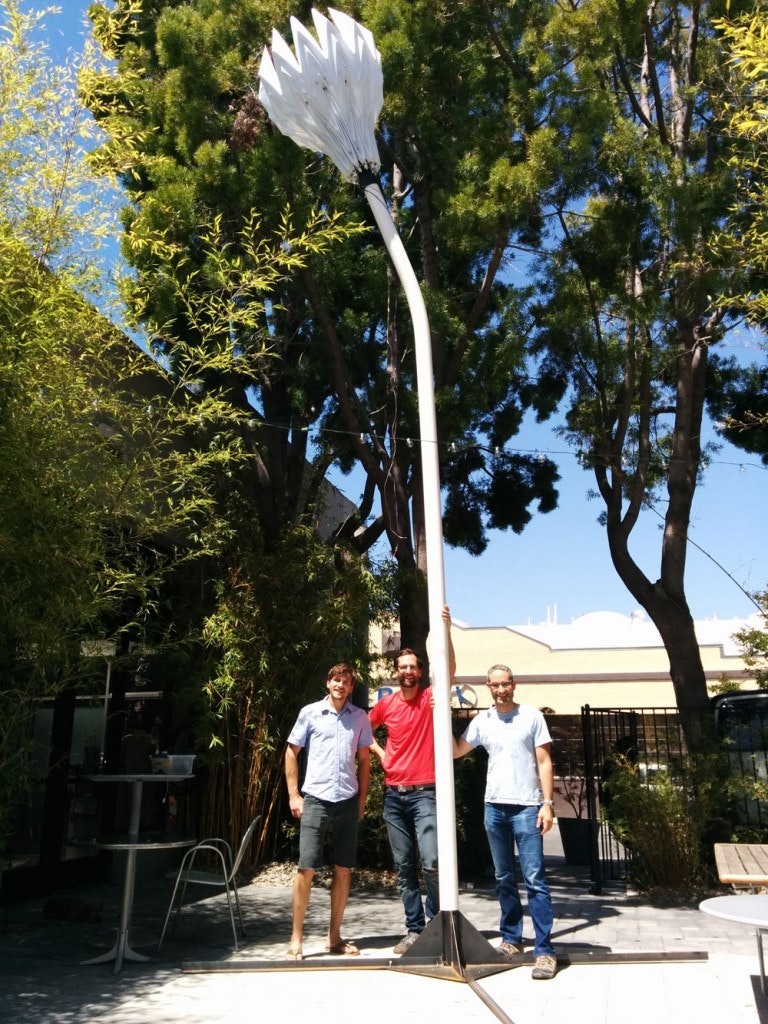Planting an Interactive Flower Garden in the Middle of the Desert
.webp)
When I moved to the Bay Area to join IDEO, I had never even heard of Burning Man. But once I got here, it came up almost every time I showed someone my Ha-Ori shelter, a collapsible origami structure I designed and built while studying at the Royal College of Art in London.

The Ha-Ori shelter was inspired by the folded leaves of the Hornbeam tree, which are lightweight and strong. People kept telling me that it was perfect for Burning Man, in both look and function. But what they didn’t know was that I hadn’t figured out how to add a good ventilation system for hot climates, so the shelter would actually have been way too hot for the desert. I vowed that I would only go to Burning Man if I brought a new iteration of the shelter with me, specifically designed for the desert weather. It took me a few years, but eventually I got together with a few other IDEO designers and we built a cool, shady Burning Man yurt. We’ve since brought the yurt to three “burns” and it still stands like a rock and is fully functional.
The idea for Blumen Lumen came up during one of those trips to the Black Rock desert. For most of the year, the Burning Man site is lifeless. The soil is dry and alkaline, so nothing grows there, and in the arid summer season, no animals ever cross it. It occurred to us that bringing flowers out there would bring a little bit of life, beauty, and love to the desert, which is a big part of what people are looking for at Burning Man. And we could use the same lightweight, folded construction that we had proven to be efficient and durable with the yurt.

The idea is for the installation to appear like a mirage in the barren, hostile desert. Seeing the flowers on the horizon, you’ll have little idea of their scale, but as you get closer, you’ll realize that it’s a true oasis: a gigantic garden of flowers up to 20 feet tall.

And then you’ll see that the flowers are discovering you as well: The blossoms open and close when they sense that people are nearby, and Arduino-controlled LED strips hidden inside the flower buds change color and intensity in response to movement and sound. The flowers contain infrared and ultrasonic sensors that detect a person’s approach, and a central computer parses inputs from the sensors and wirelessly controls and coordinates the individual blooms.
The opening and closing of the flowers is not only a beautiful motion, it is also an essential safety measure so the flowers can withstand the high winds in the desert, which can reach more than 60 miles an hour. Making the flower strong enough has been one of the biggest engineering challenges of the project.
The flower buds are made from two sheets of 5-by-10-foot corrugated polypropylene, which is very strong for its weight. We rout out lines on both sides of the sheet to create fold guides that determine where and in which direction the sheet should fold. (We learned when building the yurt that this process is very time-intensive when done by hand, so this time we outsourced it.) The sheets are then folded and welded together on both sides.

For the opening and closing mechanism, we built a telescoping “stamen” out of PVC pipe and connected it to 12 aluminum struts, which are then attached to the origami structure of the petals. The mechanism works like an upside-down parasol, which is lovely, but it means that we are fighting gravity, so we had to create a lot of force in order to close the flower. We experimented with pneumatic pistons, but bringing compressed air to the desert seemed impractical, and we felt we wouldn’t achieve an elegant enough motion. We’ve since gone through three different iterations of actuators, and we ended up with a 150lb, 18-inch linear actuator with a worm drive. It’s a lot slower than other actuators we tried, but it’s also cheaper, and it provides a lot of force in a small package. Best of all, it cannot be back-driven, which means we don’t need any electricity to keep the flowers shut.

The stem is made from a 4-inch PVC pipe, which slides over a 10-foot-long steel pipe that is screwed into a base in the ground. The base is also made of steel and is dug three feet into the earth, with four 4-foot outriggers that reach out horizontally and are also buried underground. We wanted the stem to have a graceful, natural curve, but we found out that bending 4” PVC pipes is not easy. We ended up using a weed burner to soften the PVC and then bending it over a curved wooden template. To make sure the tube doesn’t collapse, we capped it on both sides and slightly pressurized it.
The diverse challenges of this project required a whole team of industrial and interaction designers as well as mechanical and digital engineers, all passionate (crazy?) enough to spend many nights and nearly every weekend for months making this surreal flower garden a reality. As you might have guessed, every person on the team either works at IDEO now or has in the past. Where else would you find such talented wackos?

You’ll be able to check out Blumen Lumen even if you don’t make it out to Burning Man—we received an initial grant of $6,000 from the Black Rock Art Foundation to show the piece in public spaces around San Francisco. The grant facilitated the exploration and prototyping phase, but to fulfill our complete vision of the project, we are now trying to raise $10,000 on Kickstarter to build the rest of the flowers and buy four solar panels, batteries, and a small generator. Chip in, and come see us in the desert!
The core team for Blumen Lumen includes Beau Trincia, Jesse Silver, Jimmy Chion, Remy Pieron, Nivi Ramesh, and Joerg Student; we had big contributions from Chris Glaister, Steve Moore, and Marco Triverio.


Get in touch



